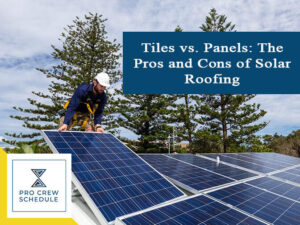In this era of civilization, going green isn’t just a trend, it’s a necessity. With pollution statistics skyrocketing, more and more industries choose to take the economically friendly route, even construction. Now that many new greenways are popping up, adding and contradicting traditional methods, it can be tricky to stay organized.
To properly manage a roofing construction business, project management software is the best tool project managers can use to stay on top of things, especially in a time where everything is fast-paced. Ultimately, it can help the whole project progress smoothly and efficiently while marrying the client’s eco-friendly wants and construction needs. They can create a builder schedule, store important documents, and keep track of the entire project all in one place.
With today’s technology advancements, solar energy can power a whole house with just panels or tiles. That’s where a subcontractor scheduling software comes in handy. Instead of keeping a rolodex of the subcontractors on the project, you can use this tool to know when and where they should work– in this case, a house that needs solar roofs. In addition to that, having a construction schedule software at hand can help make the whole process cleaner and more efficient.
How Solar Energy Works
Solar energy is not a new thing. It’s actually been used by Greeks and Romans in 3rd century BC to start fires through mirrors and glasses. However, things have gotten more sophisticated since then.
1. The solar panels are made up of silicon photovoltaic (PV) cells. These cells then absorb the sunlight’s rays when the sun hits the panels. Then, through the Photovoltaic Effect, electricity is produced, specifically Direct Current (DC).
2. Because DC is not home-friendly, it goes through an inverter that converts the DC electricity to Alternating Current (AC). This type of electricity is safe to be used in homes and appliances.
3. To be used by appliances, the useable AC electricity is then directed to the switchboard, which distributes the AC electricity throughout the house. Additionally, the switchboard makes sure that the house is primarily run by solar energy, only utilizing power from the grid when the solar is not enough.
4. Solar-powered homes are required to have a bi-directional meter. Through net metering, utility meter can record all power the goes into the house and track how much solar energy is brought back to the grid.
5. Finally, any solar electricity that was not used is exported back to the grid.
Pros and Cons of Using Solar Energy
Solar energy is synonymous with positive effects, particularly with the environment. However, there are also some drawbacks when choosing to have your home run on solar power.
Pros of Using Solar Energy
1.Environmentally friendly
On average, an American home produces about 15,000 pounds of carbon dioxide yearly.
Solar energy does little harm to the environment, compared to other energy sources. While it still has a negative environmental impact from infrastructures, this is minimal compared to other energy sources that use fossil fuels and emit carbon dioxide. This means that there are no direct air and water pollutants from solar power, and no greenhouse gases are released into the atmosphere.
If solar panels are installed, a home’s carbon footprint can be reduced by 3,000 pounds in a year.
2. Drastically lower electric bills
Reduced lower bills are one of the biggest reasons residents choose to go solar. Because you will generate your electricity, you will be less reliant on the electricity supply from the grid, thus lowering your monthly bills. And if you opt to go full solar, you can even eliminate electric bills.
You can cut your costs down by decades because a solar system typically has a 25 to 35-year lifespan. To paint a clearer picture, you can save up to $30,000 on electricity in 20 years.
And not only will you save, but you can also earn money from your solar system. If you have unused electricity from your system, it will be exported back to the grid, making you money.
3. Diverse applications
Solar energy is not exclusively for electricity. With solar thermal, a solar system could generate heat. So, aside from cutting costs and saving the environment, solar power can also provide clean and distilled water to areas that lack safe water and electricity to areas without access to the grid.
4. Energy independence
Unlike energy powered by gas or coal, you won’t need to worry about the source running out with solar energy. It is a known fact that the sun is an infinite energy source, you will have renewable and sustainable energy as long as it shines.
Cons of Using Solar Energy
1. Dependent on weather and surroundings
While you will have solar power as long as there is the sun, the source isn’t always guaranteed because of unpredictable weather and time. It can sometimes rain for days on end, preventing the sun from hitting the panels. Also, you won’t get a charge at night.
2. Expensive initial costs
In terms of long-term benefits, a solar-powered home can save you on your monthly bills. Be that as it may, the initial cost to have it installed is relatively high. You will not only be paying for the components, including the panels, the inverter, batteries, and wiring, but also labor and installation.
So, if you don’t have the budget, to begin with, having solar panels or shingles could be a problem in the long run.
3. Lower electricity costs, lower solar savings
The main reason residents have solar systems installed is to cut costs on monthly expenses. But if the homeowner has a small electric bill, to begin with, running on solar power will only have a small difference on monthly expenses. They might even lose money to have it installed.
For example, states like Louisiana have lower electricity costs than the national average, by about 25%, to be specific. It would be more logical for homeowners in Hawaii to have solar panels installed, where the cost of electricity is higher.
4. Needs a lot of space
The number of panels that will be used depend on how much electricity you consume and want to produce. So, if you’re going to generate a lot of power, you will need a lot of panels, which means you will need a decent amount of space.
Usually, the panels or tiles are installed on the roof. But there are times when the roof’s surface area is not enough, so some people look their yards for space. The downside to this is that they will have a shorter limit in sunlight as shadows will cast over them during the day.
The Difference Between Solar Panels and Solar Shingles
Traditionally, solar panels have been the go-to method of attaining solar power. But recently, more and more people have been investing in solar shingles or solar tiles. Let’s compare the two to see which one is better.
Is it easy to install?
Solar panels have been used in many buildings, both commercial and residential, since the early 2000s. So, it’s understandable why panels are easier to install than tiles. Contractors have been working with them for over a decade, so they understand the process seamlessly.
In addition to that, an entire roof does not need to be covered in panels to generate electricity. The number of panels will depend on how large the home is, how much power is needed and consumed.
Does it look appealing?
When it comes to visual appeal, people are more inclined to choose tiles over panels. Because solar roof tiles are purposefully designed to look like asphalt shingles and cover the whole roof, they look sleeker because they seem like they are part of the roof.
Is the technology reliable?
Since solar shingles are relatively new to the industry, much is still to be learned about it and its technology. On the other hand, solar panels have been in use since 2005, which means that manufacturers, contractors, and installers better understand it. Because it’s been known for a long time, there is little chance for surprises from panels.
Do you get your money’s worth?
Generally, solar panels cost less than solar roof tiles, despite its initial upfront cost. However, it’s important to note that panels are installed on an already-finished roof, which means that it’s an addition to construction costs.
As for solar roof tiles, they have gone down in price since its introduction in 2011, which was double the panels’ price. And the cost for this is already included in the construction.
Now, when it comes to getting your money’s worth, solar panels are still more reliable because they have proven to be durable for decades and have a 20 to 25-year warranty. Tesla, a leading technology company, has claimed that its solar roof tiles would last for 30 years, which still up for debate. But they do have an “infinite tile warranty,” which extends throughout the house’s lifetime.
Key Takeaways
As technology advances, more methods, techniques, and tools to help people go green with energy are coming up. For example, solar energy is one of the most popular ways to cut carbon emissions while also reducing costs. But before people invest in solar panels or solar roof tiles, they must first understand all its implications.





